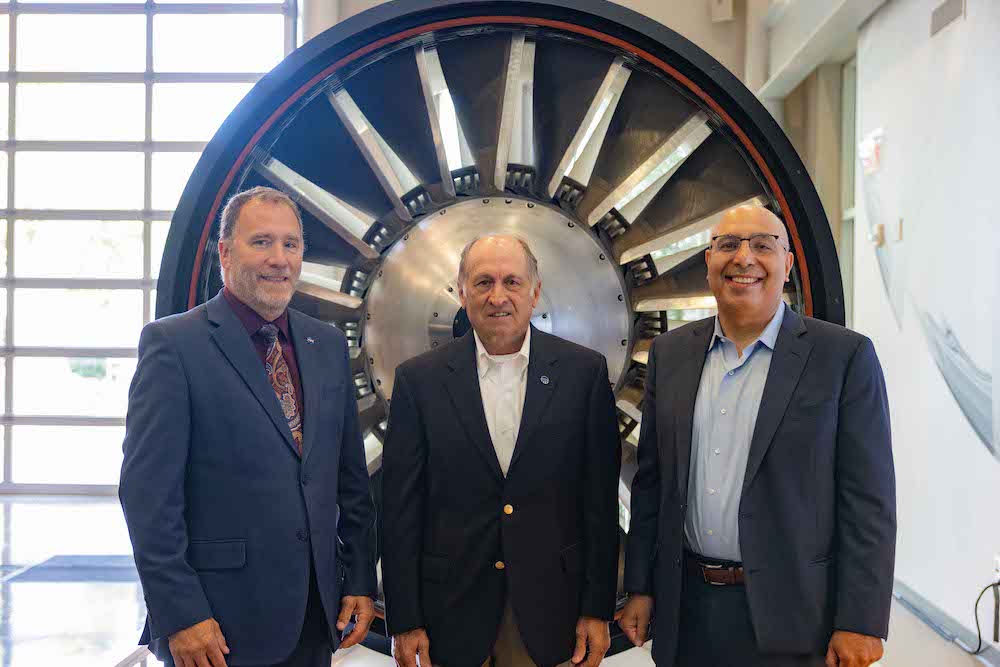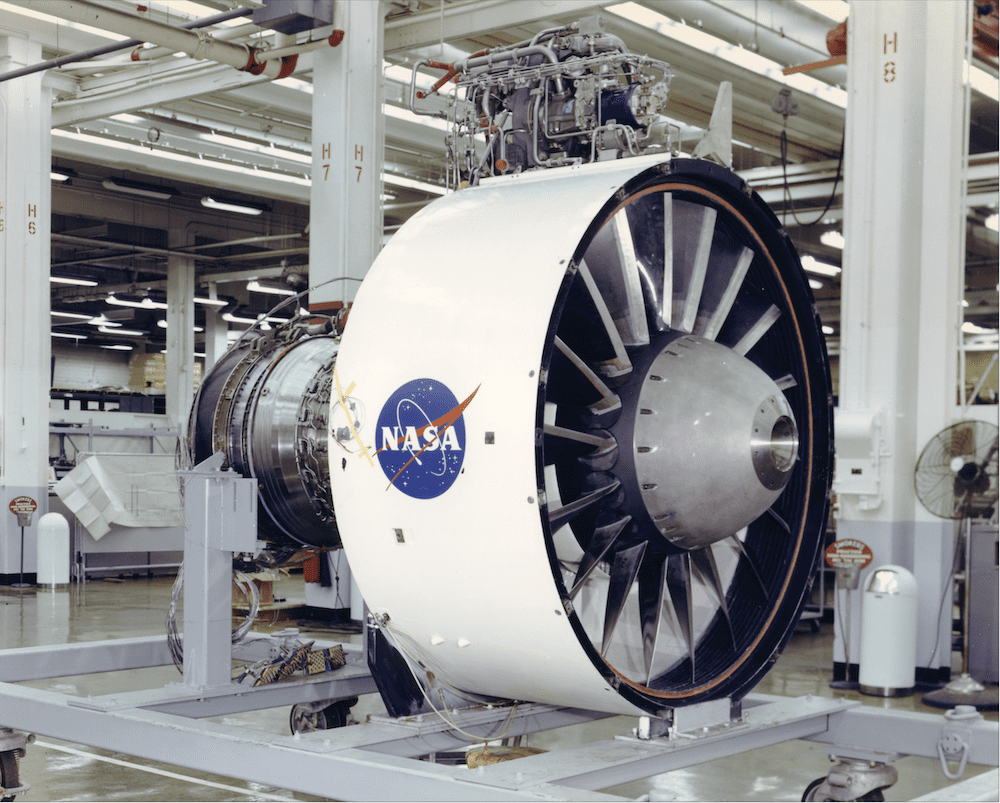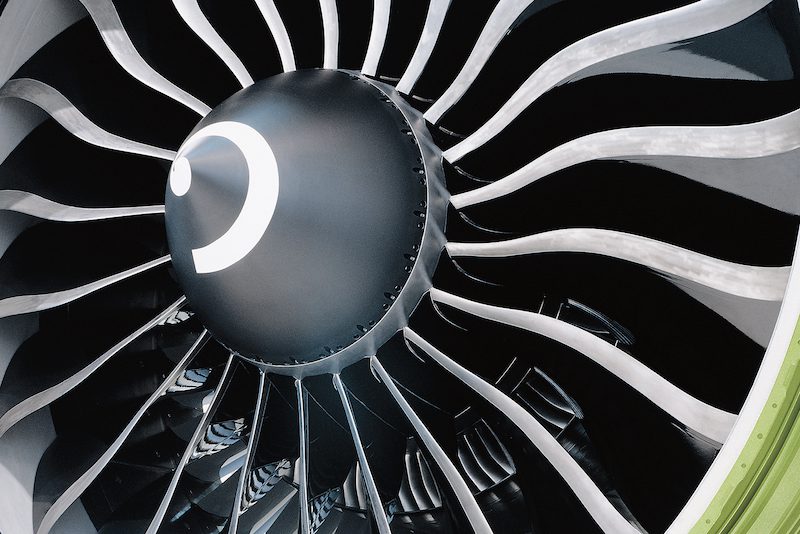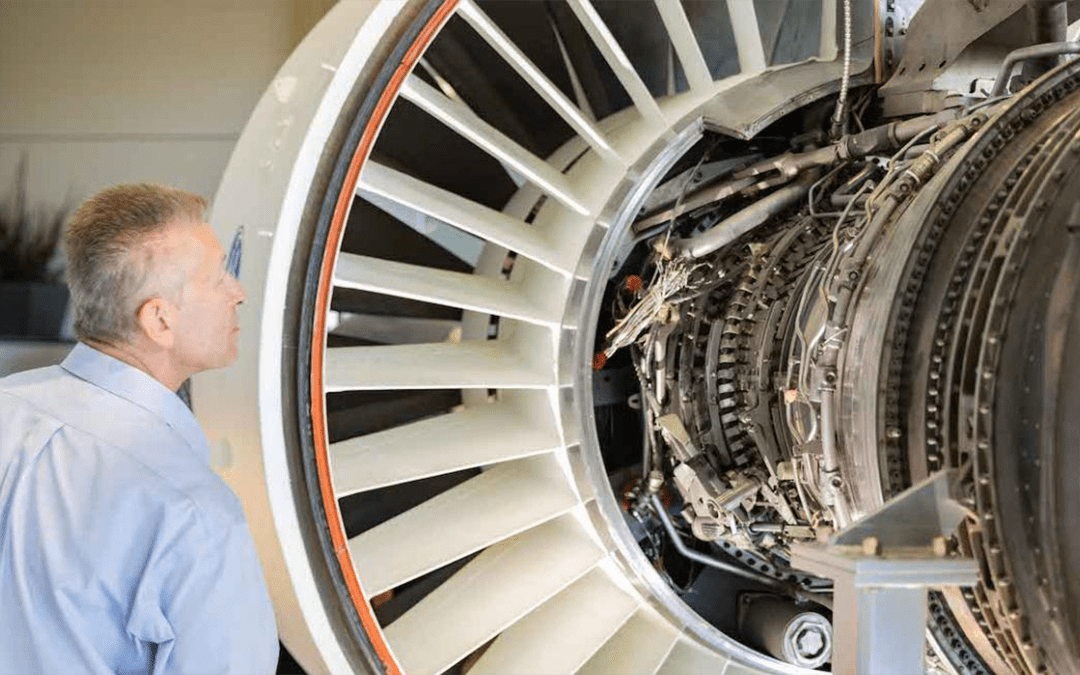“It All Started With QCSEE”: A Revolutionary Engine Finally Takes the Spotlight
September 22, 2023 | by GE Reports
The dawn of the jet age gave birth to the concept of the global village. Once jet engines made the jump from military fighters to civilian planes in the 1950s, commercial passenger service could carry people farther and faster than ever before. Fares dropped, ticket sales quadrupled, and by 1972 almost half of all Americans had traveled by air.
But more people flying also meant more complications. To reduce runway congestion and noise, industry leaders envisioned a fleet of quiet short-haul jets that could take off and land using small airfields in less densely populated areas, freeing the major terminals for cross-country and intercontinental flights. In 1974, NASA awarded GE a contract to design and test an engine that could meet the demands of the growing segment of short-haul traffic. What resulted was a suite of groundbreaking technologies — some soon pressed into production, others far ahead of their time — in the form of the Quiet Clean Short-Haul Experimental Engine (QCSEE).
One of GE’s first commercial technology demonstration programs, QCSEE affirmed the promise of more fuel-efficient flight. As part of the contract, GE built two experimental engines — an over-the-wing unit and an under-the-wing variant. Now GE is taking the QCSEE out of storage and putting it on display. Starting September 21, visitors to the GE Aerospace Learning Centre in Evendale, Ohio, can see the engine that, according to Chief Engineer Chris Lorence, “provided the basis for our commercial product portfolio as we know it today.”
Because they are not intended for commercial production, demonstration engines give designers the freedom to take risks and explore ideas. With QCSEE, GE engineers seized the opportunity to be bold. In an effort to dampen noise, they overhauled the prevailing jet engine design and ended up confirming that many of the characteristics that make an engine quiet also make it efficient.
“An aircraft engine can generate thrust either by accelerating a little bit of air by a lot, or by accelerating a lot of air by a little,” explains David Ostdiek, a lead engineer on GE’s latest demonstrator, the RISE program, which is being developed by CFM International, a 50-50 joint company between GE and Safran Aircraft Engines. Turbojet engines, common on midcentury airliners, adopt the former strategy: Most of the air that enters the engine flows through the core, where it is pressurized, mixed with fuel, and ignited. It then shoots out as a narrow stream of ultra-fast exhaust, propelling the plane forward.
Turbojets made possible the fast flight speeds of the early jet age, but they also guzzled fuel, and their high-velocity exhaust produced most of the noise associated with these aircraft. For a quieter engine, the QCSEE engineers revisited a concept GE had implemented a handful of times in the 1950s and ’60s: the turbofan. Based on the second method of producing thrust — accelerating a large mass of air by a little — turbofan engines channel most of the airflow around the core rather than through it. Driven by the fan, this air also creates thrust when it exits out the back of the engine. The ratio of the masses of each stream — the air that skirts around the core and the air that passes through it — is called the bypass ratio. Thanks to slower total exhaust flow, engines with higher bypass ratios are quieter. They’re also more efficient, because when less air moves through the core, less fuel burns.
The QCSEE engines, which incorporated a gearbox to help slow down the fan speed, had an unprecedented bypass ratio in the range of 11:1, meaning that for every unit of air that passed through the combustion chamber, 11 units bypassed the combustion process. “QCSEE helped prove to the world that we could advance high bypass ratios to get more efficient engines,” Lorence says. “All commercial engines today are going to higher and higher bypass ratios.” GE applied the lessons from QCSEE to develop a succession of more efficient high-bypass commercial engines, including the CFM56 (under CFM International), the GE90, the GEnx, and the CFM LEAP.
[Continued after sidebar]
——————————————————————————————————————
Five Key Technologies Advanced by QCSEE
The technologies GE developed for QCSEE laid the groundwork for the next 50 years of engine designs. Here are five lessons from the program that are still guiding innovation.
Low-pressure, high-bypass fans. Directing more air around the engine core, rather than through it, leads to huge fuel savings.
Composites. Lightweight polymer components used in the fan blades, frame, and outer case reduce weight.
Variable pitch. When the engine’s fan blades rotate as well as spin, the pilot can balance lift and thrust at different speeds.
FADEC/digital control. Electronic controls help pilots manage increasingly versatile engine systems.
Acoustic treatments. High-bypass engines are inherently quieter than alternatives in the same thrust class. Perforated inner and outer walls, sound-absorbing panels, and slower-moving fan blades also help dampen engine noise.
——————————————————————————————————————
Of course, pushing a larger mass of air requires a wider fan, as well as a thicker hub and a bigger case to contain them both. If made of metal, these components would weigh the plane down. So the engineers tested lighter graphite and Kevlar components for the fan blades, frame, and outer case, and a graphite-polymer resin for the fan’s inner duct. “These composite materials were the key enabler for high efficiency,” Ostdiek says. Some 20 years later, the GE90 became the first commercial jet engine to be certified with composite fan blades; composite materials also helped boost the GEnx’s fuel efficiency by up to 15% over that of its predecessor, the CF6.
To cut yet more weight, the QCSEE team pioneered the use of variable-pitch fan blades. In the under-the-wing model, each blade could pirouette within its slot in the hub to face incoming air at different angles, allowing the pilot to optimize the balance between lift and thrust as airspeed changed. The blades could even rotate 180 degrees to blow air out the front of the engine, eliminating the need for a conventional thrust reversal system to assist with braking after landing. Although the technology has not yet been used in a production model, variable pitch is a key component of the RISE program’s open fan architecture.
To help the pilot manage the intertwined variables of blade pitch, fan speed, and thrust, the QCSEE team replaced traditional hydraulic levers with a digital control system that maintained operation within safe limits. A few years later, GE introduced digital controllers in its commercial engines; the company’s most recent generation of products — the Passport, GEnx, CFM LEAP, and GE9X engines — have full-authority digital engine controls, or FADEC. “In any modern engine, electronics control every system,” Lorence says. “That all started with what we demonstrated in QCSEE.”
The QCSEE program ended in 1978, but its innovations have lived on in nearly five decades of GE engines. The company sees the RISE program following in its footsteps, spawning the next generation of more sustainable technology. “RISE is the culmination of everything we demonstrated in QCSEE — high bypass facilitated by a gearbox, composite fan blades, digital electronic controls, variable pitch — plus all that we’ve learned since then,” Lorence says. “That’s why it’s going to be an industry leader in efficiency.”
At a company that has achieved a lot of firsts, QCSEE may have slipped under the radar, forgotten as a string of ever more advanced engines came to market. But in the Learning Centre, it’s going to finally get the attention it deserves. “While we think about how we’re going to invent the future,” Lorence says, “this is an opportunity to show appreciation for the heritage that got us to where we are today.”
But more people flying also meant more complications. To reduce runway congestion and noise, industry leaders envisioned a fleet of quiet short-haul jets that could take off and land using small airfields in less densely populated areas, freeing the major terminals for cross-country and intercontinental flights. In 1974, NASA awarded GE a contract to design and test an engine that could meet the demands of the growing segment of short-haul traffic. What resulted was a suite of groundbreaking technologies — some soon pressed into production, others far ahead of their time — in the form of the Quiet Clean Short-Haul Experimental Engine (QCSEE).
One of GE’s first commercial technology demonstration programs, QCSEE affirmed the promise of more fuel-efficient flight. As part of the contract, GE built two experimental engines — an over-the-wing unit and an under-the-wing variant. Now GE is taking the QCSEE out of storage and putting it on display. Starting September 21, visitors to the GE Aerospace Learning Centre in Evendale, Ohio, can see the engine that, according to Chief Engineer Chris Lorence, “provided the basis for our commercial product portfolio as we know it today.”
 The ribbon cutting at GE Aerospace headquarters on Sept. 21: From left, Tim McCartney, NASA John Glenn Research Center director of aeronautics; Jan Schilling, a retired GE Aerospace engineering leader who worked on the QCSEE program; and Mohamed Ali, GE Aerospace vice president of engineering. All images: GE Aerospace
The ribbon cutting at GE Aerospace headquarters on Sept. 21: From left, Tim McCartney, NASA John Glenn Research Center director of aeronautics; Jan Schilling, a retired GE Aerospace engineering leader who worked on the QCSEE program; and Mohamed Ali, GE Aerospace vice president of engineering. All images: GE Aerospace
Because they are not intended for commercial production, demonstration engines give designers the freedom to take risks and explore ideas. With QCSEE, GE engineers seized the opportunity to be bold. In an effort to dampen noise, they overhauled the prevailing jet engine design and ended up confirming that many of the characteristics that make an engine quiet also make it efficient.
“An aircraft engine can generate thrust either by accelerating a little bit of air by a lot, or by accelerating a lot of air by a little,” explains David Ostdiek, a lead engineer on GE’s latest demonstrator, the RISE program, which is being developed by CFM International, a 50-50 joint company between GE and Safran Aircraft Engines. Turbojet engines, common on midcentury airliners, adopt the former strategy: Most of the air that enters the engine flows through the core, where it is pressurized, mixed with fuel, and ignited. It then shoots out as a narrow stream of ultra-fast exhaust, propelling the plane forward.
 The Quiet Clean Short-Haul Experimental Engine developed by GE and NASA in 1978.
The Quiet Clean Short-Haul Experimental Engine developed by GE and NASA in 1978.
Turbojets made possible the fast flight speeds of the early jet age, but they also guzzled fuel, and their high-velocity exhaust produced most of the noise associated with these aircraft. For a quieter engine, the QCSEE engineers revisited a concept GE had implemented a handful of times in the 1950s and ’60s: the turbofan. Based on the second method of producing thrust — accelerating a large mass of air by a little — turbofan engines channel most of the airflow around the core rather than through it. Driven by the fan, this air also creates thrust when it exits out the back of the engine. The ratio of the masses of each stream — the air that skirts around the core and the air that passes through it — is called the bypass ratio. Thanks to slower total exhaust flow, engines with higher bypass ratios are quieter. They’re also more efficient, because when less air moves through the core, less fuel burns.
The QCSEE engines, which incorporated a gearbox to help slow down the fan speed, had an unprecedented bypass ratio in the range of 11:1, meaning that for every unit of air that passed through the combustion chamber, 11 units bypassed the combustion process. “QCSEE helped prove to the world that we could advance high bypass ratios to get more efficient engines,” Lorence says. “All commercial engines today are going to higher and higher bypass ratios.” GE applied the lessons from QCSEE to develop a succession of more efficient high-bypass commercial engines, including the CFM56 (under CFM International), the GE90, the GEnx, and the CFM LEAP.
[Continued after sidebar]
——————————————————————————————————————
Five Key Technologies Advanced by QCSEE
The technologies GE developed for QCSEE laid the groundwork for the next 50 years of engine designs. Here are five lessons from the program that are still guiding innovation.
Low-pressure, high-bypass fans. Directing more air around the engine core, rather than through it, leads to huge fuel savings.
Composites. Lightweight polymer components used in the fan blades, frame, and outer case reduce weight.
Variable pitch. When the engine’s fan blades rotate as well as spin, the pilot can balance lift and thrust at different speeds.
FADEC/digital control. Electronic controls help pilots manage increasingly versatile engine systems.
Acoustic treatments. High-bypass engines are inherently quieter than alternatives in the same thrust class. Perforated inner and outer walls, sound-absorbing panels, and slower-moving fan blades also help dampen engine noise.
——————————————————————————————————————
Of course, pushing a larger mass of air requires a wider fan, as well as a thicker hub and a bigger case to contain them both. If made of metal, these components would weigh the plane down. So the engineers tested lighter graphite and Kevlar components for the fan blades, frame, and outer case, and a graphite-polymer resin for the fan’s inner duct. “These composite materials were the key enabler for high efficiency,” Ostdiek says. Some 20 years later, the GE90 became the first commercial jet engine to be certified with composite fan blades; composite materials also helped boost the GEnx’s fuel efficiency by up to 15% over that of its predecessor, the CF6.
To cut yet more weight, the QCSEE team pioneered the use of variable-pitch fan blades. In the under-the-wing model, each blade could pirouette within its slot in the hub to face incoming air at different angles, allowing the pilot to optimize the balance between lift and thrust as airspeed changed. The blades could even rotate 180 degrees to blow air out the front of the engine, eliminating the need for a conventional thrust reversal system to assist with braking after landing. Although the technology has not yet been used in a production model, variable pitch is a key component of the RISE program’s open fan architecture.
To help the pilot manage the intertwined variables of blade pitch, fan speed, and thrust, the QCSEE team replaced traditional hydraulic levers with a digital control system that maintained operation within safe limits. A few years later, GE introduced digital controllers in its commercial engines; the company’s most recent generation of products — the Passport, GEnx, CFM LEAP, and GE9X engines — have full-authority digital engine controls, or FADEC. “In any modern engine, electronics control every system,” Lorence says. “That all started with what we demonstrated in QCSEE.”
 Composite fan blades first tested with the QCSEE program in the 1970s were further developed and introduced into service with the GE90 commercial aircraft engine.
Composite fan blades first tested with the QCSEE program in the 1970s were further developed and introduced into service with the GE90 commercial aircraft engine.
The QCSEE program ended in 1978, but its innovations have lived on in nearly five decades of GE engines. The company sees the RISE program following in its footsteps, spawning the next generation of more sustainable technology. “RISE is the culmination of everything we demonstrated in QCSEE — high bypass facilitated by a gearbox, composite fan blades, digital electronic controls, variable pitch — plus all that we’ve learned since then,” Lorence says. “That’s why it’s going to be an industry leader in efficiency.”
At a company that has achieved a lot of firsts, QCSEE may have slipped under the radar, forgotten as a string of ever more advanced engines came to market. But in the Learning Centre, it’s going to finally get the attention it deserves. “While we think about how we’re going to invent the future,” Lorence says, “this is an opportunity to show appreciation for the heritage that got us to where we are today.”
